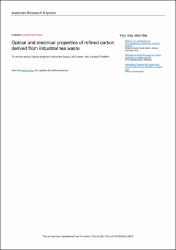| dc.contributor.author | Akgül, Gökçen | |
| dc.contributor.author | Bıçakcı, Saliha Nur | |
| dc.contributor.illustrator | Akgül, Gökçen | |
| dc.contributor.illustrator | Bıçakcı, Saliha Nur | |
| dc.date.accessioned | 2020-12-19T19:34:49Z | |
| dc.date.available | 2020-12-19T19:34:49Z | |
| dc.date.issued | 2020 | |
| dc.identifier.citation | Akgül, G. & Bıçakcı, S.N. (2020). Optical and electrical properties of refined carbon derived from industrial tea waste. Materials Research Express, 7(4), 045604. https://doi.org/10.1088/2053-1591/ab8995 | en_US |
| dc.identifier.issn | 2053-1591 | |
| dc.identifier.uri | https://doi.org/10.1088/2053-1591/ab8995 | |
| dc.identifier.uri | https://hdl.handle.net/11436/1178 | |
| dc.description | Akgul, Gokcen/0000-0001-6101-7971 | en_US |
| dc.description | WOS: 000530461200001 | en_US |
| dc.description.abstract | The utilization of nano- and well-ordered carbon materials such as graphene especially in carbon-based electrical devices and in energy storage areas is becoming important in terms of developing economical methods and reducing the dimensions of the electrical devices. These applied carbon materials are mostly originated from fossil sources which are diminishing. Hence, renewable carbon resources are gaining importance. Biomass is the single renewable carbon resource and can be refined to highly ordered carbon materials such as graphene by top to down methods. in this work, industrial tea waste biomass was converted to carbonized material by pyrolysis and refined by some further chemical treatments towards the ordered structured carbon. the newly derived refined carbon material was characterized by Raman, TGA, FTIR, SEM and XRD methods, and its optical and electrical properties were determined. the experimental results showed that the band gap energies of refined carbon derived from tea waste and reduced graphene oxide prepared in this study are in the similar level as 2.375 and 2.264 eV, respectively. Furthermore, the electrical conductivities are at the same stage as 3.16 and 3.28 x 10(-4) (1/omega cm) for reduced graphene oxide and refined carbon. the optically active and electrical conductive refined carbon material from biomass could be a proper carbon in energy related applications in terms of renewable and sustainable processing. | en_US |
| dc.description.sponsorship | Recep Tayyip Erdogan University, Scientific Research Projects Coordinator Unit (BAP) [FYL-2018-970] | en_US |
| dc.description.sponsorship | We gratefully acknowledge the financial support provided by Recep Tayyip Erdogan University, Scientific Research Projects Coordinator Unit (BAP) (Project No: FYL-2018-970). | en_US |
| dc.language.iso | eng | en_US |
| dc.publisher | Iop Publishing Ltd | en_US |
| dc.rights | info:eu-repo/semantics/openAccess | en_US |
| dc.subject | Tea waste | en_US |
| dc.subject | Reduced graphene oxide | en_US |
| dc.subject | Optical | en_US |
| dc.subject | Electrical | en_US |
| dc.subject | Refined carbon | en_US |
| dc.title | Optical and electrical properties of refined carbon derived from industrial tea waste | en_US |
| dc.type | article | en_US |
| dc.contributor.department | RTEÜ, Mühendislik ve Mimarlık Fakültesi, Enerji Sistemleri Mühendisliği Bölümü | en_US |
| dc.identifier.doi | 10.1088/2053-1591/ab8995 | |
| dc.identifier.volume | 7 | en_US |
| dc.identifier.issue | 4 | en_US |
| dc.ri.edit | oa | en_US |
| dc.relation.journal | Materials Research Express | en_US |
| dc.relation.publicationcategory | Makale - Uluslararası Hakemli Dergi - Kurum Öğretim Elemanı | en_US |


















